As a newcomer to Hanoi I find myself in daily awe of many people gathering around the sidewalk food stands, of the throngs of motorbikes winding and weaving their way up Hue city street and down Ba Trieu street, and of the intrepid tourists who confront – however timidly or courageously – the sensory overload that is the Old Quarter. Sometimes, however, every city dweller needs to escape the sound and the fury of downtown activity.
 After what feels like a little too long following road markings for Bat Trang, a large sign appears on the right with the name of this lovely village, which specialises in hand-made, hand-painted ceramics in all shapes and sizes. Upon our arrival, my girlfriend and I puttered around the streets with the dwindling afternoon light casting crisp silhouettes of power lines on chipping plaster walls the colour of lemon sherbet. There were women drinking tea in front of a cement mixer and a pile of bricks with the clear intention of filling the void left by a torn down building. We passed overflowing shops with ceramics of all sorts on offer. Our senses were bombarded by the meandering melody of mournful music, the strident scent of burning incense wafting out from the Buddhist temple, and a huge crowd of people with white headbands spilling out onto the streets after a funeral ceremony was just wrapped up. Inside the shops, the variety is incredible: tea sets, mugs, ash trays, plates, vases – small, large, and humongous. Then there are the ceramic figures of dogs, Buddha, Confucius, turtles, Bugs Bunnies, elephants, lions, eagles; you name it, they have it.
A bit overwhelmed by the sheer quantity of shops, we tried one of the larger ones n the main street, Huong Xuan, where all manners of dishware are sold in both the traditional Chinese blue and white motif as well as in a range of contemporary styles and colours. We purchased a couple of pieces as gifts for people back home, but the best part was yet to come.
The man in the showroom is a kind and welcoming individual, and if asked politely, he will allow paying customers to see the production facilities. In one part of the factory, a dozen or so women operate huge press machines, which hollow out lumps of fresh clay, turning them into vases or drinking vessels. From there, low wooden planks are loaded with fresh pieces and carried upstairs into the kiln room. Two kilns larger than some studio apartments I’ve lived in are packed with hundreds of pieces waiting to be fired. The perfectly uniform cups, saucers, and teapots arranged in repetitive rows and columns of gray clay forms are visually striking. The next room over is designated for painting and glazing. After the pieces come out of the kiln the first time, another dozen or so women paint intricate blue and white patterns and calligraphy on them with the narrowest of brushes. Be warned: the grace and ease with which the women apply complicated motifs to their ceramics can easily mesmerize; on our visit, we stood there slack-jawed for what must have been ten minutes before giving a little bow to the forewoman and heading outside. We hopped on our motorbike and headed back toward the city feeling eminently refreshed; we were ready once more to face the traffic and constant activity that assaults the senses in the city. If you are looking for a bit of time away, and you do not have a motorbike, you can take the 47 bus from Long Bien bus station for VND5,000 or you can take a taxi for around VND200,000 each way.
Provide by Vietnam travel guide
|
Thứ Sáu, 26 tháng 4, 2013
A TRIP TO BAT TRANG CERAMIC VILLAGE
Visiting a traditional craft village along the Red River banks is a good way of escaping the busy life of the capital city and exploring the age-old ceramic craft making.
Thứ Ba, 23 tháng 4, 2013
Contemplating sparkling beauty of Phu Quoc island
Being in the southwest of Kien Giang province, Phu Quoc is the most biggest island in Vietnam with stunning scenery.
Spending three days discovering the island during three days, tourists will have a lot of unforgettable experiences, and memories.
There are two ways to go to Phu Quoc. Firstly, tourists go by plane from Hanoi or Ho Chi Minh City. Secondly, they can go by high-speed train.
There are two ways to go to Phu Quoc. Firstly, tourists go by plane from Hanoi or Ho Chi Minh City. Secondly, they can go by high-speed train.

As many people know, Phu Quoc is very famous for ridgeback dogs. The Phu Quoc Ridgeback dog is one of only three breeds that have a ridge of hair that runs along its back in the opposite direction to the rest of the coat. This breed’s ability is to run, jump, and swim faster than most other breeds. Also, ridgeback dogs are very adorable, especially puppies.

Besides the special breed of dog, Phu Quoc is also well-known with pepper. Planting pepper appeared in Phu Quoc for hundreds year ago and it becomes traditional work in Phu Quoc. Phu Quoc pepper is spicy and hot, especially red pepper. Planting pepper in Phu Quoc is different from other places. The farmers rarely use chemical fertilizer. Every year, root of pepper tree is banked with new soil that is digged from garden edge in order to modify nutrition used or washed away. That way makes pepper trees grow naturally.


Coming to Phu Quoc, tourists can visit Ganh Dau - a communce in the northwest of Phu Quoc island with pristine beaches and charming landscapes. If not, tourists can go to Bai Dai beach (“the long beach” in Vietnamese) stretching 15 kilometers to the northwest. This is a beautiful beach with fine and clean sand and the ocean water with mild temperatures.





In addition, travelers cannot miss the most beautiful beach on the island – Sao beach. It deserves to be one of five most beautiful beaches in the world.
Thứ Tư, 17 tháng 4, 2013
Travel experience in Da Nang during April 30 holiday
Known as the most liveable city in Vietnam, Da Nang attracts many tourists to visit every year. If you make plan to visit here for April 30th holiday, you should read the following interesting experiences.
-86f89/kinh-nghiem-du-lich-da-nang-dip-304.jpg)

-86f89/kinh-nghiem-du-lich-da-nang-dip-304.jpg)
-86f89/kinh-nghiem-du-lich-da-nang-dip-304.jpg)
-86f89/kinh-nghiem-du-lich-da-nang-dip-304.jpg)
-86f89/kinh-nghiem-du-lich-da-nang-dip-304.JPG)
-86f89/kinh-nghiem-du-lich-da-nang-dip-304.jpg)
-86f89/kinh-nghiem-du-lich-da-nang-dip-304.jpg)
-86f89/kinh-nghiem-du-lich-da-nang-dip-304.jpg)
-86f89/kinh-nghiem-du-lich-da-nang-dip-304.jpg)
-86f89/kinh-nghiem-du-lich-da-nang-dip-304.jpg)
-86f89/kinh-nghiem-du-lich-da-nang-dip-304.jpg)
Travel
Da Nang is a big, young and modern city with almost travel vehicles at airports, train stations, international port, crowded bus stations, so it is very convenient for you to get to Da Nang. If you want to be on the plane, it just takes about 1 hour for you to get to Da Nang from Hanoi or HCMC. However, plane ticket on this occasion is quite expensive and sold out, so you have to book tickets early.
It will be convenient and exciting if you decide to travel by high quality bus or car with VND 400,000/ turn. However, in these days, tickets are always sold out or more expensive.
It will be convenient and exciting if you decide to travel by high quality bus or car with VND 400,000/ turn. However, in these days, tickets are always sold out or more expensive.
-86f89/kinh-nghiem-du-lich-da-nang-dip-304.jpg)
Because Da Nang is quite big with many intriguing sights, so if this is the first time you have ever visited it, you can travel by taxi. Taxis here are in abundance.
If you want to save your money or explore scenery with free style, you can hire bicycles and motorcycles of hotel. And it is from VND 70,000 for bicycle and VND 120,000 for motorcycle per day. In addition, visitors can hire cyclo if you want to enjoy the night scene along the banks of Han River or take a stroll to enjoy the beauty of city.
Hotel
If you want to save your money or explore scenery with free style, you can hire bicycles and motorcycles of hotel. And it is from VND 70,000 for bicycle and VND 120,000 for motorcycle per day. In addition, visitors can hire cyclo if you want to enjoy the night scene along the banks of Han River or take a stroll to enjoy the beauty of city.
Hotel
Da Nang has a lot of hotels from ordinary hotel to 5-star or luxury resorts along the coastline Pham Van Dong. Depending on the budgets, every visitor can give the right choice.

If you want to save your budget, you can rent guess houses at Hoa Khanh street, Lien Chieu district from VND 100,000 -200,000 per night. Also, you can find outlying hotels on Nam O Street with the price of VND 300.000 per night.
Hotel room rates on Dien Bien Phu or Hoa Khanh Street fluctuate from over VND 600.000. And nearer hotels cost from VND 1.000.000 to 3.000.000 per night on Bach Dang Street. However, because of too many tourists to Da Nang on occasion so if you should book rooms about 1 month ago causing room rates are also increased from 2 to 3 times.
Tourist places.
Hotel room rates on Dien Bien Phu or Hoa Khanh Street fluctuate from over VND 600.000. And nearer hotels cost from VND 1.000.000 to 3.000.000 per night on Bach Dang Street. However, because of too many tourists to Da Nang on occasion so if you should book rooms about 1 month ago causing room rates are also increased from 2 to 3 times.
Tourist places.
Da Nang has numerous destinations that are extremely attractive to most tourists coming here. Coming here, you definitely should not miss Khe beach- one of the most exotic beaches in Vietnam. You will be enchanted by blue water, the stretch of white sand and fresh seafood here.
-86f89/kinh-nghiem-du-lich-da-nang-dip-304.jpg)
The next destination is Marble Mountains, about 7m far from Da Nang center. The weather will be more pleasant if you visit Marble Mountains in the early morning or at 3 pm. Marble Mountains is majestic. From the top, you will see Da Nang overall. Here also many souvenirs by stone with affordable prices.
-86f89/kinh-nghiem-du-lich-da-nang-dip-304.jpg)
Linh Ung pagoda was built in Son Tra Peninsula al well as tourist attraction that you should not miss. This pagoda was built extremely elaborately. Linh Ung pagoda is famous for Mercy Goddess.
-86f89/kinh-nghiem-du-lich-da-nang-dip-304.jpg)
The pagoda has become a place of worshiping, living and learning of nuns, Buddhist, as well as being tourist attraction of tourists all around the country.
Ling Ung pagoda is a spiritual tourist attraction ò Da Nang city. At night, Linh Ung pagoda has become more beautiful and shimmering.
-86f89/kinh-nghiem-du-lich-da-nang-dip-304.JPG)
If you have time, you should come to Ba Na that is well known as the paradise. Certainly, you will not forget the feeling of floating when sitting in cable car.
-86f89/kinh-nghiem-du-lich-da-nang-dip-304.jpg)
In addition to cool air, there are many entertainment areas and the largest buildings with incredibly beautiful Western architecture. In order to enjoy all the beauty of Ba Na, you should stay here for one night. If you want to explore culture here, you should visit Cham Museum situated in the city center.
-86f89/kinh-nghiem-du-lich-da-nang-dip-304.jpg)
The beautiful and majestic bridges such as Han River Bridge, Dragon Bridge, Thuan Phuoc Bridge are also very interesting tourist destination.
-86f89/kinh-nghiem-du-lich-da-nang-dip-304.jpg)
About 30km far from Da Nang, Hoi An is an ideal destination. Hoi An ancient city attracts many visitors. Immersing ancient space at sunset, you will feel more comfortable and relax.
-86f89/kinh-nghiem-du-lich-da-nang-dip-304.jpg)
Eating and shopping
Da Nang is a coastal city so seafood is extremely rich. You can enjoy fresh seafood along the coastline Pham Van Dong.
-86f89/kinh-nghiem-du-lich-da-nang-dip-304.jpg)
-86f89/kinh-nghiem-du-lich-da-nang-dip-304.jpg)
If you want to enjoy the specialties of Da Nang city like girdle cake rolled pork, noodle, Tran store will be perfect destination for you.
In addition, there are so many famous snacks such as pancakes, noodles, fish salad…
Thứ Sáu, 12 tháng 4, 2013
Visiting village temple – soul of Vietnam’s rural community
Belief and religion are just one side of culture. Culture includes many others. However, the temple is not only for religious expression but also reflects many other aspects of culture.
Together with two other common village symbols—the banyan tree and the well—the temple is essential to the spiritual life of almost all people in rural areas.
 |
| Dinh Bang village temple in Bac Ninh |
The village temple serves as a common playground for kids, a place of worship for adults, and an ideal meeting hall for village elders to impart their wisdom to youngsters.
Every village in the countryside has its own temple and grounds that transform into a venue for religious rituals and contests during traditional festivals. The temple is also a launching pad for national patriotic movements or acts of charity.
The lead-up to the spring and Lunar New Year (Tet) holiday is an especially busy time as villagers make use of temple ground for communal preparations and celebrations. They gather for music and dance performances, and folk games like wrestling, ball throwing, and tug-of-war.
For centuries, the village temple has functioned as both a communal house and a place of worship dedicated to village founders and other notables who are seen as the source of all wisdom.
Every village in the countryside has its own temple and grounds that transform into a venue for religious rituals and contests during traditional festivals. The temple is also a launching pad for national patriotic movements or acts of charity.
The lead-up to the spring and Lunar New Year (Tet) holiday is an especially busy time as villagers make use of temple ground for communal preparations and celebrations. They gather for music and dance performances, and folk games like wrestling, ball throwing, and tug-of-war.
For centuries, the village temple has functioned as both a communal house and a place of worship dedicated to village founders and other notables who are seen as the source of all wisdom.
 |
| Hang Kenh village temple in Haiphong |
As a token of local culture, lifestyle and traditions, a typical village temple is built on highest ground with its huge wooden pillars resting on square stones. The temple roof is often constructed to evoke the shape of a ship and its intricate decoration includes images of dragons, flowers of four seasons, and human activity.
Villagers assemble at their temple on special occasions to offer incense and pray for fair weather, happiness, prosperity, and good luck.
Many old village temples have been preserved in good shape. Some like Dinh Bang temple in Bac Ninh, Hang Kenh temple in Hai Phong, and Tra Co temple in Quang Ninh are living proof of original architectural styles which already reached a high level of civilization centuries ago.
Villagers assemble at their temple on special occasions to offer incense and pray for fair weather, happiness, prosperity, and good luck.
Many old village temples have been preserved in good shape. Some like Dinh Bang temple in Bac Ninh, Hang Kenh temple in Hai Phong, and Tra Co temple in Quang Ninh are living proof of original architectural styles which already reached a high level of civilization centuries ago.
 |
| Pillars of village temple |
Their impressive features are mentioned in local metaphors and similes to describe things, for instance, “as big as village temple pillars”, or “as huge as a village temple”. The image of the village temple is also depicted in poems and folksongs, as in the saying:
“Qua đình ngả nón trông đình,
Đình bao nhiêu ngói thương mình mấy nhiêu”
Đình bao nhiêu ngói thương mình mấy nhiêu”
(Passing by, she doffs her hat towards the temple,
Her pangs of love could match its richly tiled roof).
Thứ Tư, 10 tháng 4, 2013
Ton Thanh Pagoda
The ancient pagoda of Ton Thanh is located in My Loc Commune, Can Giuoc District, Long An Province. The 200 year-old pagoda is the place where Nguyen Dinh Chieu, a great poet and patriotic scholar lived and the most celebrated works in Vietnamese literature.
According to history books, Ton Thanh Pagoda with its initial name of Lan Nha was built by Buddhist monk Vien Ngo in the year of the 7th Gia Long (1808). In the year of the 5th Thieu Tri, Buddhist monk Vien Ngo, who followed the Buddhist religion for 40 years but did not reach the peak of the way in his religion, decided to sit in meditation without drinking water for 49 days and then passed away. To commemorate the monk who devoted his whole life to the Buddhist religion, the locals call the pagoda Tang Ngo or Ong Ngo and Lao Ngo.
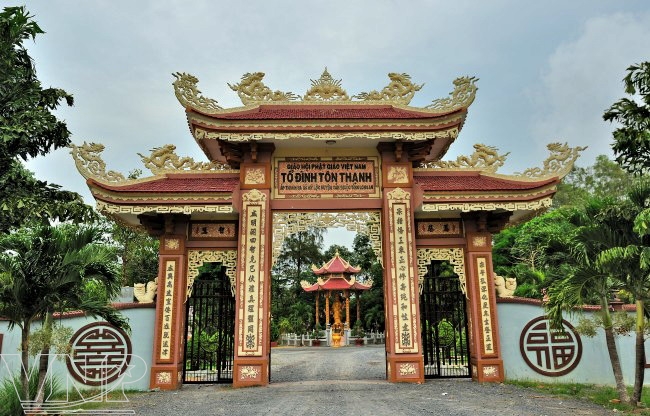
Ton Thanh Pagoda is the oldest one in Long An Province.

According to “Dai Nam Nhat Thong Chi” (Essays on the United Great Vietnam)
Ton Thanh Pagoda was the most famous one in Gia Dinh Area (in the past).
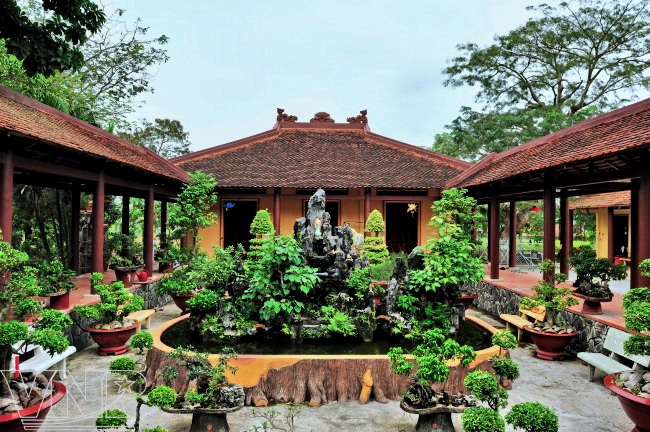
Despite being restored several times, Ton Thanh Pagoda built in 1808 retains its 19th
century architectual style.

Beautiful patterns of the pagoda's roof.
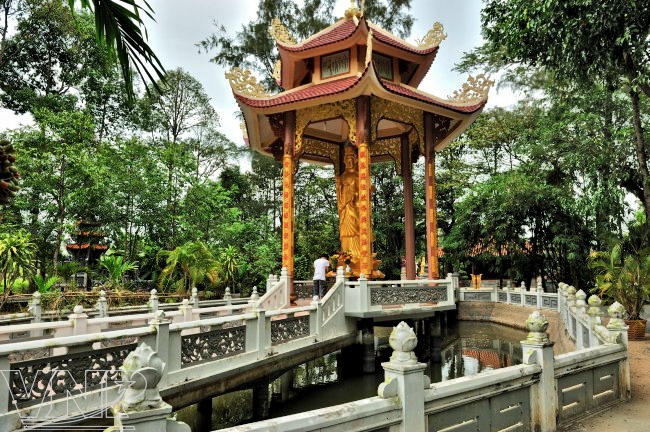
Visiting the pagoda, tourists have a chance to learn about the ancient architectural work
and its historical value.
Sixteen years latter, Ton Thanh Pagoda became famous for being the place where poet Nguyen Dinh Chieu wrote “Van Te nghia si Can Giuoc” (Funeral Oration for the Partisans of Can Giuoc). During three years living in the pagoda, from 1859 to 1861, the blind poet wrote many literary works and made up medicine to treat the locals. In a surprise attack on Tay Duong Military Post in Truong Binh Market on the night of the 15th day of lunar calendar in the Year of Cock (1861), one of the three wings of Can Giuoc Insurgent Army started from Tan Thanh Pagoda. The insurgent army killed a mandarin of the French, called Hai Phu Lang Sa by the locals. Being moved and fired up by the courageous sacrifices of Can Giuoc soldiers, poet Nguyen Dinh Chieu created “Van te nghia si Can Giuoc” at Ton Thanh Pagoda.
At present, the relics of poet Nguyen Dinh Chieu and the “Van te nghia si Can Giuoc” are still preserved at the precinct of the pagoda. They are two steles, one about poet Nguyen Dinh Chieu built in 1973 and the second excerpting “Van te nghia si Can Gioc” built in 1998. In the garden of the pagoda, there are a three-story tower in the shape of hexagon, 4.5m high, of monk Vien Ngo with the highest storey inscribed with scripts “Glory to Buddha Amitabha” and a square three-storey Tower, 3m in height of Buddhist Monk Tac Thanh.
After being restored several times, the pagoda has experienced a lot of changes. It now consists of a complex of a worshiping hall, a sanctum, a preaching house and corridors in the west and the east. Particularly, the pagoda only preserves the old architectural style with a system of four pillars in the main sanctum, several Buddhist statues from the early 19th century, parallels and the most valuable statue of Ksitigarbha Bodhisattva which is 110m high and is made from bronze.
At present, the relics of poet Nguyen Dinh Chieu and the “Van te nghia si Can Giuoc” are still preserved at the precinct of the pagoda. They are two steles, one about poet Nguyen Dinh Chieu built in 1973 and the second excerpting “Van te nghia si Can Gioc” built in 1998. In the garden of the pagoda, there are a three-story tower in the shape of hexagon, 4.5m high, of monk Vien Ngo with the highest storey inscribed with scripts “Glory to Buddha Amitabha” and a square three-storey Tower, 3m in height of Buddhist Monk Tac Thanh.
After being restored several times, the pagoda has experienced a lot of changes. It now consists of a complex of a worshiping hall, a sanctum, a preaching house and corridors in the west and the east. Particularly, the pagoda only preserves the old architectural style with a system of four pillars in the main sanctum, several Buddhist statues from the early 19th century, parallels and the most valuable statue of Ksitigarbha Bodhisattva which is 110m high and is made from bronze.
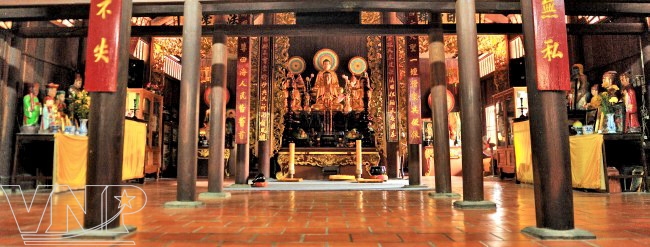
The central chamber of Ton Thanh Pagoda.
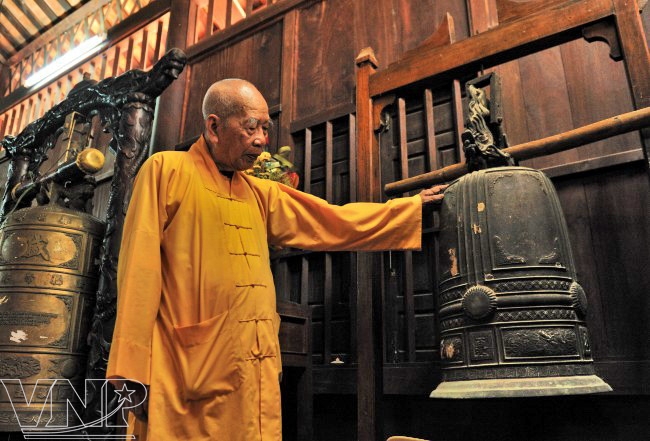
The ancient bell in Ton Thanh Pagoda.

A row of Arhats inside Ton Thanh Pagoda.
With historical values, Ton Thanh Pagoda has become a destination, attracting a large number of tourists.
Thứ Sáu, 5 tháng 4, 2013
Cross Jungle to Discover Mai Waterfall
The entrance road of Mai Waterfall is small, paved with gravel. Because it has just opened for a short time, visitors will have chance to ride their motorbikes with the excitement from feeling mystery of crossing jungle to discover Mai Waterfall.
After three hours riding motorbike from Sai Gon, reaching Dau Day intersection then turning left to Highway 20, going about 10 kilometers far from La Nga bridge, following the small road across the forest 20 kilometers further, people will see Mai Waterfall which is belongs to Dinh Quan district, Dong Nai province.

The entrance road of Mai Waterfall is small, paved with gravel. Because it has just opened for a short time, visitors will have chance to ride their motorbikes with the excitement from feeling mystery of crossing jungle to discover Mai Waterfall.
The sudden bends likes huge elbows continuously appearing into view, this makes the riders frequently be in passive situation.
The air in Mai Waterfall area is very pure, cool with vast forest having varieties of specious plants that brings to visitors plentiful vitality.

Mai Waterfall includes many big rocks. The rock surfaces are flat like granite table, suitable for the visitors to freely play, chat and slowly enjoy foods, drinks.
Under the forest canopy, below the rock surfaces, behind the strongly flowing waterfall, there are hanging bridges, rope bridges adventurously swaying.

Actually, when building the hanging bridges, people planed to choose the part where water flew the most drastically in order to create the adventure, interest for visitors.
When walking on the bridge, despite of securely holding the fence, if people just focus their eyes on the waterfall which is strongly flowing, they will definitely shocked blinded and suffer from the worry of “freely dropping” into the waterfall.
So come to Mai Waterfall, visitors need to be calm and a little brave to try the adventurous feeling of walking on the hanging bridges, rope bridges.
In spring, the whole landscape of Mai Waterfall seems to be covered by a brilliantly yellow velvet coat of five-or-six-petal apricot blossoms which are big, strangely brightly yellow.

Travel to Mai Waterfall, tourists can not only contemplate the wonderful, mysterious scenery of waterfall and forest but also soak their feet in hot spring in Mai Waterfall eco-tourism zone.
This is a natural hot spring which is 7 hectares in width, surrounded by all year green vegetation.
Mai Waterfall will be an ideal destination for visitors during the tour from Ho Chi Minh City to Da Lat, or the tours to La Nga, Cat Tien or Madagui…
Thứ Tư, 3 tháng 4, 2013
Lung Cu - A High Forehead of The Motherland- Ha Giang Vietnam
From a distance, Lung Cu is a spectacular sight in Ha Giang and referred to as “A high forehead of the motherland.” Tourists in Vietnam travel getting the chance to visit this Northern mountainous province don’t miss an attractive- tourist destination- Lung Cu where you can take in the imposing beauty of landscapes and the diverse ethnic groups living. Especially, you can see the Lung Cu flagpole, inspiring a deep sense of pride in Vietnamese.
 From a distance, Lung Cu is a spectacular sight, with the view dominated by giant boulders and the national flag flying above Dragon Mountain, all set to the backdrop of magnificent forests.
From a distance, Lung Cu is a spectacular sight, with the view dominated by giant boulders and the national flag flying above Dragon Mountain, all set to the backdrop of magnificent forests.
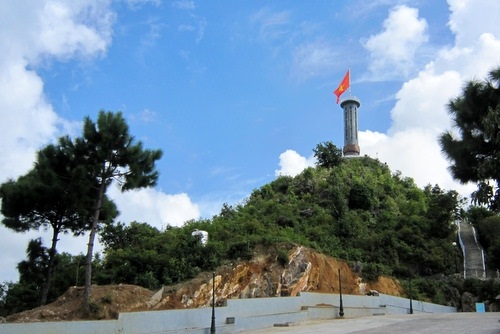
Driving over 400km from Hanoi following National Highway 2 and 4C, the rocky plateau of Dong Van awaits visitors in Vietnam travel, with mountain paths like blood vessels sticking to the land standing between them and the summit of Lung Cu.
 From a distance, Lung Cu is a spectacular sight, with the view dominated by giant boulders and the national flag flying above Dragon Mountain, all set to the backdrop of magnificent forests.
From a distance, Lung Cu is a spectacular sight, with the view dominated by giant boulders and the national flag flying above Dragon Mountain, all set to the backdrop of magnificent forests.
The flag tower itself stands proudly 1,600m above sea level. Its design is an imitation of the Hanoi Flag Tower, with eight bronze drums guarding the sides of the octagonal tower. The national flag adorning the top of the 135-stair tower has an area of 54m², symbolizing the unity of Vietnam’s 54 ethnic groups.
From the top of Dragon Mountain, the paddy fields and earthen-walled houses dot the sumptuous panorama, interrupted by two lakes that are said to be the dragon’s eyes. Even though people say that Lung Cu is a ‘thirsty’ land, the lakes never dry out.
The houses in Lung Cu also betray the superstitions of the people who live in them. Charms hang over the doors to expel demons and evil spirits, and the ancestral altar is carefully placed opposite the main door. The houses are usually open plan, but when newly-weds are welcomed into a family, the hosts use fabric to make a private compartment for them to enjoy.
Lung Cu Commune is home to nine villages, situated at a height of between 1,600-1,800m above sea level. In the winter, the weather is very cold, and sometimes it even snows. There are seven ethnic groups in Lung Cu. They are very friendly and hospitable. Visitors to their houses are considered distinguished guests, even if they are strangers. A bowl of their maize wine will soon warm you up.

Most ethnic people in the area cultivate rice and the Mong and Lo Lo still preserve the traditional weaving industry with flax fibres.
Lung Cu is also the land of the peach, the plum, tea, honey wine and Thang Co (horse meat hot pot). The bustling markets where the honey-yellow sunlight has never changed, the cheerful, shy smiles of the ethnic girls in colorful, handmade dresses, the playful grins on the children’s faces, and the welcoming nature of the people as a whole never fail to charm visitors in Vietnam travel.
Đăng ký:
Bài đăng (Atom)